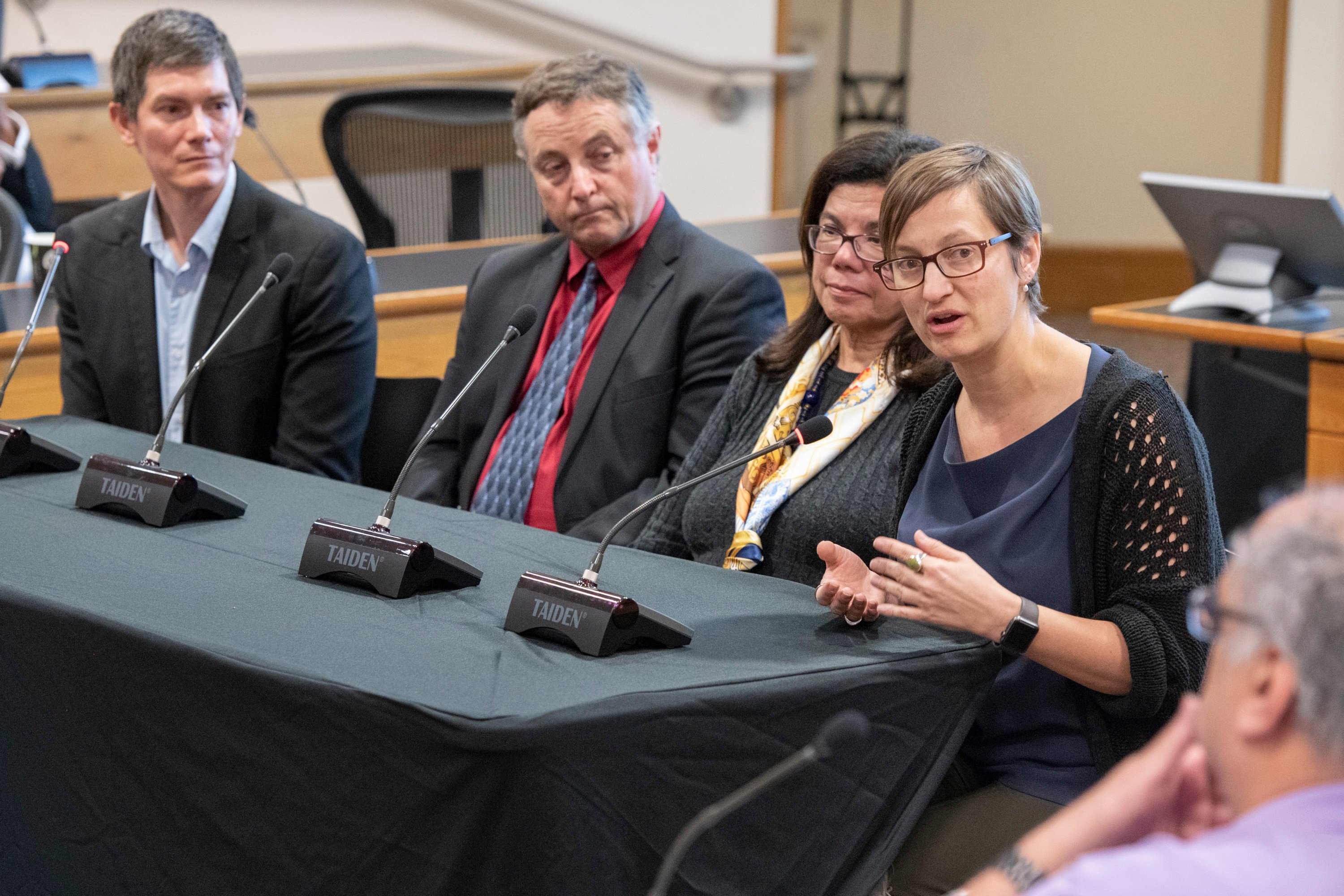A panel of faculty members presented their departments’ efforts toward promoting diversity and inclusion in the Faculty Senate’s last meeting of winter quarter. The discussions emphasized strides made in hiring practices for faculty and graduate admissions, along with inclusive environments in stereotypically non-diverse fields.
The Senate also discussed Stanford’s official stance on academic journals with paywalls, the Hoover Institution’s relationship to undergraduates and Stanford’s relationship with Palo Alto high schools.
Memorial resolutions were also given for the founder of the comparative literature program Herbert Lindenberger and former investment professor at the Graduate School of Business John “Jack” McDonald B.S. ’60, M.B.A. ’62, Ph.D. ’67, who died last year.
Diversity and inclusion practices
The main report of the meeting was on diversity and inclusion practices at the University, which included presentations from a panel including physics professor Risa Wechsler, medical school faculty development and diversity dean Yvonne Maldonado, mechanical engineering and student affairs dean Thomas Kenny and chemical engineering professor Thomas Jaramillo.
Wechsler discussed her department’s efforts to promote diversity and inclusion through teaching practices and support student groups. The Equity and Inclusion Committee, formed in the summer of 2016, started with faculty volunteers and encouraged active learning in classes to address the low enrollment of women or underrepresented minorities.
She said these efforts, while ongoing, have led to an increase from 20 percent to 29 percent in female undergraduate physics majors, with an increase from zero to six percent for black or Latina women.
Maldonado discussed the importance of making faculty aware of their “unconscious bias” through diversity training. She also pushed for incorporating diversity advisors in processes for selecting new faculty, and also showed how the medical school is using diversity dashboards to monitor their faculty and student representation and compare their figures to national data.
Kenny described the importance of instilling an appreciation of diversity in students.
“We have the opportunity to interact with a disproportionate amount of future leaders,” he said. “We can change how they see diversity by allowing them to experience success with a diverse environment.”
The engineering school has seen a 50 percent increase in female and underrepresented minorities in Ph.D. programs since 2015. Additionally, efforts for undergraduates like the Stanford Summer Engineering Academy (SSEA) and Additional Calculus for Engineers (ACE) are gaining prominence in helping students from under-resourced schools adjust to the workload in college.
Jaramillo honed in on the process of searching for faculty, saying that the chemical engineering department has experimented with more standardized rubrics and shorter interviews to select more diverse faculty, which he said he would continue. He also encouraged faculty in other departments to share their hiring practices to develop a “toolkit” of approaches and procedures.
The members of the Faculty Senate were appreciative of the panel members’ efforts, but Wechsler emphasized how faculty encouraging diversity were volunteering their time and pushed for more systematic attention to the issue.
“We need to change the incentive structure for faculty,” he said. “Structural incentives do not reward work toward diversity, which makes it much harder to work towards.”
Hoover Institution
Professor Rush Rehm also asked Drell and Tessier-Lavigne about the Hoover Institution, which has been the subject of controversy at previous Faculty Senate meetings.
“I am not proposing a litmus test for political correctness, but drawing the attention to the fact that right-wing ideologues under the Stanford banner are spreading, not research or facts, but a kind of propaganda that does not hold up to academic scrutiny,” Rehm said.“The Hoover is not a research institution or a knowledge-producing institution, but a partisan, ideologically driven policymaking group.”
Drell emphasized the importance of having multiple ideological perspectives on campus.
“I think there is a broad diversity of work that comes from Hoover,” Drell said. “We live in the marketplace of ideas. I encourage faculty who do not think that is scholarly work to challenge it in the way that we do in the marketplace of ideas.”
“If you look at the Hoover website — please have something better to do — but it appears that the opinions of the Hoover Institute are not exactly endorsed by, but definitely under the imprimatur of Stanford University,” Rehm responded. “It is only that that upsets me. Is this my marketplace? And it sounds to me like it not only is my marketplace, or our marketplace, but we don’t have a lot to say about it. That is my problem.”
Open-access publications
The Senate discussed the cost of subscriptions for the University of California (UC) schools for journals owned by publishing company Elsevier.
Provost Persis Drell noted that Elsevier’s contract with the UC schools is system-wide, and they were negotiating a new agreement when talks broke down.
Stanford has two separate contracts with Elsevier — one for the medical library and one for the main library — and neither of them are of the magnitude of the UC system.
“The main library contract is on year two of a five-year contract, which makes it a little more challenging for us when it comes to negotiations,” Drell said. “That said, we are all watching the UC situation very carefully, and we will want to keep that in mind as we approach the end of the five years.”
Several faculty members also noted the importance of keeping the potential downstream page charges in mind for individual faculty members when deciding Stanford’s position on open-access journals.
Contact Yash Pershad at ypershad ‘at’ stanford.edu.
